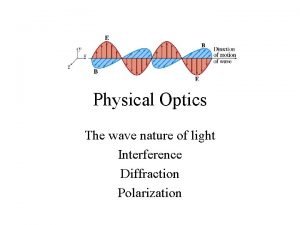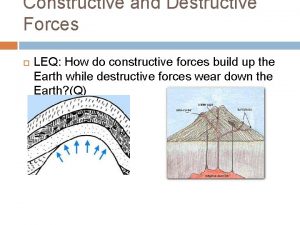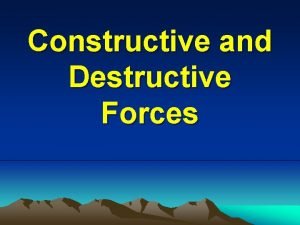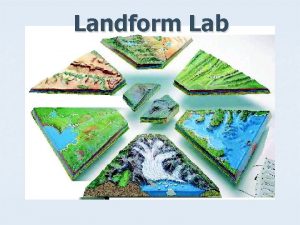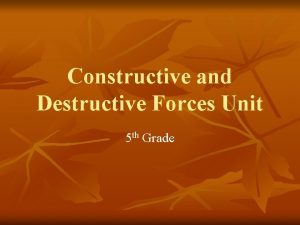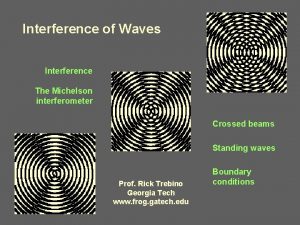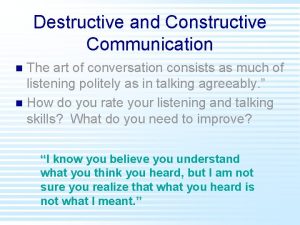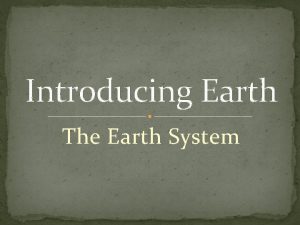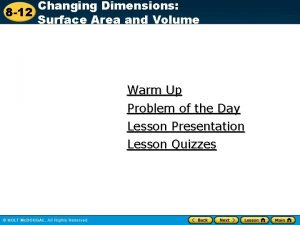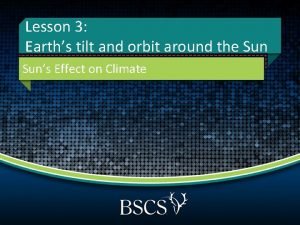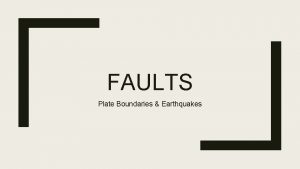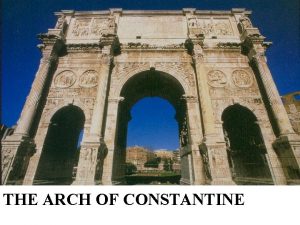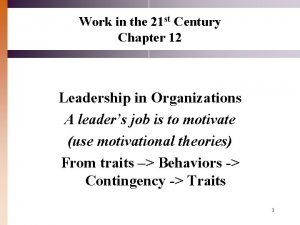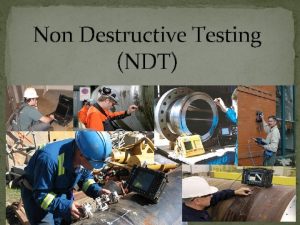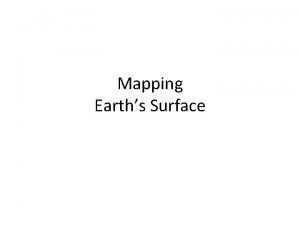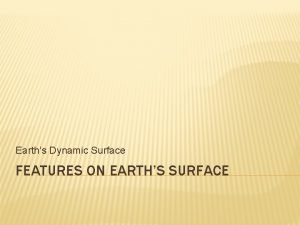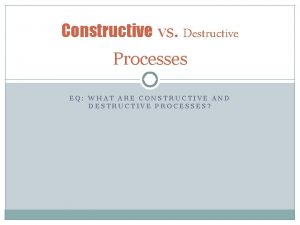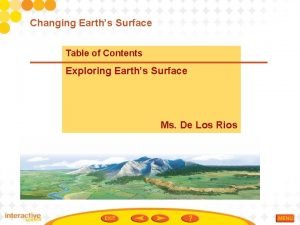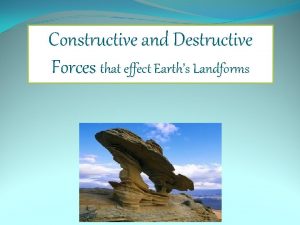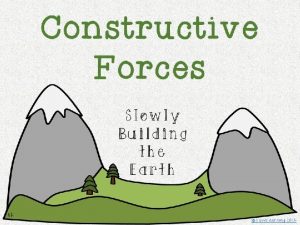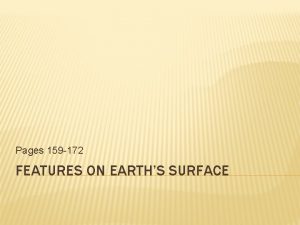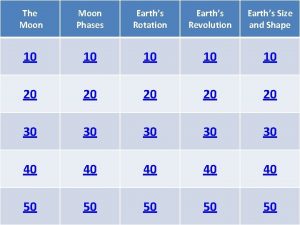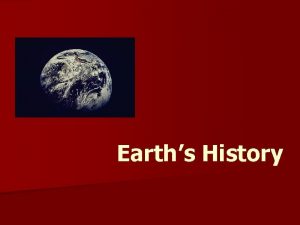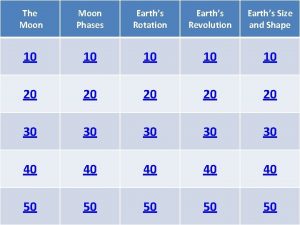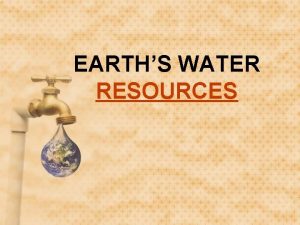Constructive or Destructive Changing Earths Surface Constructive Destructive





















































- Slides: 53

Constructive or Destructive? Changing Earth’s Surface

Constructive? Destructive? Ø What do these two terms mean? l l Constructive: Destructive: Ø What, on Earth, would you consider to be constructive and destructive? Ø What causes the constructive and destructive events on Earth?

Tectonic Plate Boundaries Ø As you know, tectonic plate boundaries are responsible for many changes on Earth. What are some of those features and events? Ø Which of these are Constructive? Destructive?

Volcanoes Ø Are Volcanoes constructive or destructive? Ø Give an example of when they could be one or the other, or even both.

Ring of Fire Ø The Ring of Fire refers to the large amount of volcanoes that wrap around the Pacific Ocean. Ø That sounds like a lot of new land being formed. How long do you think it takes to develop life on those islands?

What is a fault? Ø We are still dealing with compression, tension, and shear stress. Faults and animations Ø More faults and animations Ø Hanging and Foot walls Ø

The Three Types of Faults Ø Caused by tension Ø Caused by compression Ø Caused by shear stress

Mountains Ø How were mountains formed at tectonic plate boundaries? Ø How else do mountains form?

Mountains Ø By the end of this section you should have recorded information on l l Fault-block mountains Upwarped mountains Volcanic mountains Folded mountains

Aren’t All Mountains the Same? Ø Check out this little video about the types of mountains. Ø Mountains

The Four Types of Mountains Ø Fault Block Volcanic

The Four Types of Mountains Ø Folded Upwarped

Can You Make It? Ø Mount Everest Game

What Do You Know? Ø In your assigned groups, answer the four questions with as many good answers as possible. Ø You are competing for bonus points, so don’t discuss your answers too loudly!!

Weathering Ø Weathering, in general, is the breakdown of rock into smaller and smaller pieces. Ø You may also consider the movement of material due to weathering processes

Mechanical Weathering Ø Mechanical weathering is the breakdown of rock by PHYSICAL means, such as ice, wind, water, gravity, plants, and animals

Mechanical Weathering - Ice Ø When water seeps into rocks and freezes, it expands. Ø When it expands, it breaks up the rocks.

Mechanical Weathering - Wind Ø Wind causes abrasion when it blows smaller rocks and sand against other rocks, which wears them down. Ø This action is like sandpaper.

Mechanical Weathering - Water Ø Moving water causes abrasion when it carries small rocks and particles with it, which rub against other rocks, wearing them down. Ø This action is like sand paper.

Mechanical Weathering - Water Ø Underground water flow can also cause sink holes.

Mechanical Weathering - Gravity Ø Gravity causes rocks and smaller particles to fall or tumble, causing abrasion when they rub against other rocks and wear them down. Ø This action is like sandpaper.

Mechanical Weathering – Plants and Animals Ø Plant roots move into existing cracks and then continue to grow, breaking up the rock. Ø Plant roots (which usually help hold soil) can cause the soil to loosen and erode in some areas. Ø Animals create burrows and tunnels through the soil, such as ants, worms, and moles.

Chemical Weathering Ø Chemical weathering is the breakdown of rocks and minerals into new substances by CHEMICAL means such as water, acids, air, and soil.

Chemical Weathering - Water, even though it may be a slow process, can dissolve minerals and rocks. Ø This process is similar to you dissolving sugar in a glass of water. Ø

Chemical Weathering – Acid Precipitation naturally contains small amounts of acid (such as sulfuric and nitric acids) which break down materials they come in contact with. Ø This is worse in areas with lots of factories. Ø

Chemical Weathering – Acids in Ground Water Ø Sometimes water in the ground contains weak acids (such as carbonic or sulfuric acids) which dissolve rocks like limestone. Ø This process is what creates caves and caverns.

Chemical Weathering – Acids in Living Things Ø Organisms such as lichens, which grow on rocks (and trees), produce acids as a waste product. Ø These acids slowly break down the rocks. Ø This is how soil starts to form from rocks.

Chemical Weathering - Air Ø Oxygen in the air reacts with iron to create iron oxide – rust, which can be seen in rocks that contain iron.

Differential Weathering Ø When softer, less weather resistant rocks wear away and expose harder, more weather resistant rocks. Ø This is Devil’s Tower, which is the remains of the inside of a volcano.

Weathering Rate by Size Ø The smaller a rock is, the faster it will erode Ø Consider: dissolving a sugar cube or regular sugar

KEEP IN MIND. . . ØThe next slides of wave erosion, wind erosion, glaciers, and mass movement are all examples of mechanical weathering!!

Wave Energy Ø Waves carry a lot of energy, which is capable of moving large amounts of material.

Wave Energy - Beaches Ø Beaches are any area of shoreline made up of materials deposited by waves.

Wave Energy - Sea Cliffs Ø Waves erode and cut into the rock, creating steep slopes.

Wave Energy - Sea Arches Ø Sea Arches form when waves continue to erode the rock and cut through

Wave Energy - Sea Stacks Ø Sea stacks used to be connected to the mainland, but have been eroded.

Wind Erosion Ø Wind is powerful and can change the landscape. Ø The changes depend on the amount of wind and the material that makes up the land.

Wind Erosion - Dunes Ø Dunes are mounds of wind deposited sand that continue to move around.

Glaciers Ø A glacier, in general, is a large mass of moving ice.

Alpine Glaciers Ø Alpine glaciers form in mountainous areas. Ø These carve out rugged features in mountains.

Continental Glaciers Ø Continental Glaciers are large ice sheets that can cover millions of square kilometers. Ø Antarctica is covered by a glacier more than 1. 5 X the size of the U. S. and that is even up to 4, 000 meters thick in some places!

Glacial Deposits Ø Glacial deposits are all of the material that is carried and deposited by glaciers.

Glacial Deposits – Striated Drift Ø Striated Drift means that the rocks and material have been sorted out by size and are in layers.

Glacial Deposits – Till Deposits Ø Till deposits is unsorted material deposited by the glacier.

Mass Movement Ø Mass movement is the movement of any material down slope. Ø Gravity controls mass movement. Ø It can be a slow or fast process.

Mass Movement – Rock Fall Ø Loosened and exposed rock may fall in chunks or slide down a slope. Ø This happens quickly.

Mass Movement - Landslide Ø Large amounts of material move downward quickly.

Mass Movement - Mudflow Ø Mudflows are large amounts of flowing mud. Ø This happens when water combines with rocks and soil.

Mass Movement - Lahars Ø Lahars are mudflows made from water, soil, and volcanic ash. Ø This material is similar to concrete.

Mass Movement - Creep Ø Creep is a slow movement of areas of land.

References Ø Ø Ø Ø Ø Ø http: //picasaweb. google. com/jfcarr/Hocking. Hills 02/photo#5113918686357241474 http: //www-personal. umich. edu/~jensenl/visuals/album/2005/up/sandpointcliffs. jpg http: //www. uwsp. edu/geo/faculty/ritter/geog 101/textbook/images/lithosphere/eolian/wind_erosion_New_Mexico_p 0 772931600_NRCS. jpg http: //www. aegweb. org/images/Geologic%20 Hazards/CA_erosion. jpg http: //graphics. jsonline. com/graphics/news/img/apr 05/beach 2041005. jpg http: //www. worms. com/worm-pdfs/images/childrens_guide_to_vermicomposting_img_41. jpg http: //www 1. istockphoto. com/file_thumbview_approve/1068194/2/istockphoto_1068194_zion_national_park_tree_ growing_out_of_rock. jpg http: //www. slrphotographyguide. com/images/slow-water. jpg http: //www. fortunebaycompany. com/Ice%20 Floe%20 Trip/Ice%20 Cave%20 Pic. jpg http: //www. nasa. gov/centers/goddard/images/content/174100 main_planet_plants_lg. jpg http: //www. adamk. ca/images/CW 31 K. jpg http: //www. decoutances. co. uk/images/Williams%20 Stream%20 Outlet%201. jpg http: //www. dtsc. ca. gov/Pollution. Prevention/images/chemicals. JPG http: //www. dkimages. com/discover/previews/831/35069201. JPG http: //minerals. cr. usgs. gov/gips/images/baluslrg. gif http: //www. utexas. edu/depts/grg/hudson/grg 301 c/hudson_grg_301 c/schedule/4_water_geomorph_images/11_kar st/1. jpg http: //www. gallagherstravels. com/States/VA/Sarecen. Tent. Cave. Formation. jpg http: //images. jupiterimages. com/common/detail/29/71/23367129. jpg http: //earthobservatory. nasa. gov/Newsroom/Nasa. News/Release. Images/20040517/01_bandiron. jpg http: //www. letsgodigital. org/images/artikelen/39/mount-everest. jpg http: //www. marketobservation. com/blogs/media/blogs/priveq/Everest. jpg http: //scoutingclub. com/wp-content/uploads/2008/10/mount_whitney. jpg

More references Ø Ø Ø http: //www. sugarcubes. ca/sugarcubes_files/baby%20 sugar%20 cubes%20 md%20 web. jpg http: //www. cbc. ca/consumers/market/files/food/sugar/gfx/sugar_top. jpg http: //blogs. business 2. com/greenwombat/images/waves_3. jpg http: //www. destination 360. com/europe/portugal-beaches. php http: //www. brooklynparrots. com/uploaded_images/parrots-invade-nj-beaches 2 -719501. jpg http: //www. myantigua. org/antigua/images/gen_pages/beaches/ant_long_beach_lg. jpg http: //www. cinnamonrainbows. com/weeklypic/HUGE%20 Wave. jpg http: //www. celebratebig. com/pacific-northwest/vancouver-island-barkley-sound-deer-island-groupbamfield-tofino-kayaking/barkley-sound-vancouver-island-deer-group-rock-sea-arch. jpg http: //great-hikes. com/blog/images/Kalalau. Last. Cave. jpg http: //wallpaper. travelblog. org/Wallpaper/pix/tb_mui_ne_sand_dunes. jpg http: //www. uvm. edu/whale//Glaciers. What. Are. html http: //www. harbourtrust. gov. au/images/photographic/nh 09. jpg http: //coastal. er. usgs. gov/navassa/photos/ep/hike/Terrace. Cliff. jpg Ø Ø http: //www. aegweb. org/images/Geologic%20 Hazards/globalvolcanoes. png http: //www. iguanaverdetours. com/images/ivpoas. jpg Ø http: //pirate. shu. edu/~schoenma/mountains. htm Ø http: //www. waterencyclopedia. com/images/wsci_03_img 0412. jpg Ø Ø Ø Ø

And Yet Even More References Ø http: //www. susanmilne. com/glacier/gla-norsun 3. jpg http: //geoinfo. amu. edu. pl/wpk/pe/a/harbbook/c_viii/images/alpine/Bee 0050. GIF http: //www. homepage. montana. edu/~geol 445/hyperglac/morphology 1/Continental. Ice. jpg http: //www. minsocam. org/msa/collectors_corner/vft/img/glacial 1. jpg http: //geogweb. berkeley. edu/Geo. Images/Wells/geomorph/striated. jpg http: //3 dparks. wr. usgs. gov/nyc/images/fig 162. jpg http: //nesoil. com/images/tillcut. jpg http: //www. uwsp. edu/geo/faculty/ritter/images/lithosphere/mass_wasting_erosion/landslide_La_Conchita_CA_US GS_slide 21. jpg http: //www. boing. net/images/_us. yimg. com_p_ap_20050110_capt. cadd 10101102308. topix_california_storm _cadd 101. jpg http: //www. soton. ac. uk/~imw/jpg-Kimmeridge/6 KM-collapse-two. jpg http: //img. timeinc. net/time/photoessays/salvadorquake/landslide. jpg http: //hkss. cedd. gov. hk/hkss/eng/slopeinfo/images/Po. Shan. Landslide. jpg http: //www. geocities. com/Rain. Forest/8211/siano 2. jpg http: //upload. wikimedia. org/wikipedia/commons/thumb/5/51/Lahar_Mount_Pinatubo. JPG/800 px. Lahar_Mount_Pinatubo. JPG http: //www. ndsu. nodak. edu/fargo_geology/mass_wasting/mw_images/trlwood_meander_1982. jpg Ø Ø Ø http: //www. ndsu. edu/nd_geology/nd_mass_wasting/images_mass_wasting/creep_kathryn 1. jpg http: //www. uwec. edu/jolhm/EH/Below/Images/sinkhole%20 BIG. jpg http: //mcmcweb. er. usgs. gov/mcgsc/images/nixa_sinkhole_sm. jpg http: //www. gasd. k 12. pa. us/~dpompa/Plate%20 Boundaries. JPG http: //media-2. web. britannica. com/eb-media/31/20231 -004 -008 EFA 7 E. jpg Ø Ø Ø Ø
 Constructive and destructive interference
Constructive and destructive interference Constructive conflict
Constructive conflict Constructive and destructive forces activities
Constructive and destructive forces activities Constructive and destructive conflict
Constructive and destructive conflict What is constructive criticism
What is constructive criticism What is constructive force
What is constructive force Rarefraction
Rarefraction U shaped valley
U shaped valley Is strip mining constructive or destructive
Is strip mining constructive or destructive Constructive and destructive forces 5th grade
Constructive and destructive forces 5th grade The difference between constructive and destructive waves
The difference between constructive and destructive waves Constructive vs destructive interference
Constructive vs destructive interference Constructive communication examples
Constructive communication examples Constructive forces and destructive forces
Constructive forces and destructive forces Constructive proof vs non constructive
Constructive proof vs non constructive Constructive proof vs non constructive
Constructive proof vs non constructive Constructive proof vs non constructive
Constructive proof vs non constructive Rules of inference
Rules of inference How do destructive forces change the land's surface
How do destructive forces change the land's surface Effects of changing dimensions on surface area and volume
Effects of changing dimensions on surface area and volume Spring earth tilt
Spring earth tilt Dinah.com earth's layers foldable
Dinah.com earth's layers foldable Brown earth soil ireland
Brown earth soil ireland Whats earths moon called
Whats earths moon called What does earths tilt do
What does earths tilt do Pangea explanation
Pangea explanation Whats earths moon called
Whats earths moon called Atmosphere layers definition
Atmosphere layers definition Study of earth's physical features
Study of earth's physical features Forest desert tundra grassland
Forest desert tundra grassland Earths boundaries
Earths boundaries Earths crust
Earths crust Which layer of the earth slowly moves like putty
Which layer of the earth slowly moves like putty Earths major crustal plates
Earths major crustal plates Earth layers foldable
Earth layers foldable What shape is the earths orbit
What shape is the earths orbit Earth honey
Earth honey Most abundant element in earth's crust
Most abundant element in earth's crust Earths interior
Earths interior Earths early atmosphere contained
Earths early atmosphere contained Earths orbit seasons
Earths orbit seasons Earths roation
Earths roation Arch of constantine frieze
Arch of constantine frieze Earths 4 spheres
Earths 4 spheres Whats the name of earths moon
Whats the name of earths moon Plasticity in earth's layers
Plasticity in earth's layers Lateral surface area of a prism
Lateral surface area of a prism High surface tension vs low surface tension
High surface tension vs low surface tension Curved surface area and total surface area of cone
Curved surface area and total surface area of cone Padilla
Padilla Destructive testing
Destructive testing What is a destructive process
What is a destructive process Conclusion of non destructive testing
Conclusion of non destructive testing Destructive tourism
Destructive tourism
